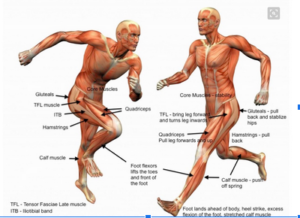Return To Racing – Preventing Injury In 2021 (Part 2)
Non-Running Exercises and Stretching
Guest Blogger: Miriam Salloum (PT OCS COMT) // The Runner’s Mechanic
In Part 1, we talked about mileage and the importance of tracking your miles and knowing the types of miles you are putting in. In Part 2, we will focus on non-running exercises and stretching as part of your training routine.
THE BEST EXERCISE MOST RUNNERS MISS!
If you are able to whittle out at least one day a week for 30-45 minutes of strength training, you can achieve improvements in performance. Improvements in strength can add anywhere from 2-8% improvements in running economy (how much oxygen or energy your body requires to run). We all know the common lifts of squats, dead lifts, side steps with bands around the ankles and lunges. There are a few forgotten muscle groups which are wonderful to start focusing on especially for those runners 35 years old and over.
Weighted Single Leg Heel Raises

https://www.openfit.com/calf-raises
The calf muscle group is a tremendous power generator. Also the Achilles tendon and plantar fascia are frequent sites of injury as runners age. To buffer the effects of decreased muscle strength and “elastic resiliency” of the calf muscle and tendons, weighted single leg heel raises can be very effective!
Start with the heel just a little dropped below the ball of the foot (you can use a book or step at home). Holding a light weight at first in one hand and holding for balance in the other, raise up the heel to the top of the range and control the descent back to the start position. 10-12 reps for 3 sets is a good place to start. As you go heavier with the weight you can decrease reps to 5-8 and increase to 4-5 sets for increased benefit.
WATCH OUT FOR THE EXTRA WORKOUTS!
One SUPER interesting, and I think helpful ,insight I have seen during the pandemic is I saw a lot of bone stress and back injuries from runners who increased their work out program with ramping up jumping or “plyometric” activities (burpees and hopping with twisting especially) I highly advise runners doing these programs to really limit heavy plyometric exercises as their mileage with their training plans increase. Impact is impact, and with some runners these extra jumping cycles can tip the scales with injury.
MAKE A PRE-RUN WARM UP FOR YOUR TENDONS A ROUTINE!
 The one thing we know about running is we need to use our tendons in a highly elastic manner, like a rubber band. Running is just bouncing from one leg to the other, over and over again, and with a goal of some kind of speed. So basically we turn ourselves into pogo sticks. Tendons need to warm up to bounce! As we age, especially past the age of 35, our tendons change in their ability to recover and handle stress. So why don’t you set yourself up for success every time?
The one thing we know about running is we need to use our tendons in a highly elastic manner, like a rubber band. Running is just bouncing from one leg to the other, over and over again, and with a goal of some kind of speed. So basically we turn ourselves into pogo sticks. Tendons need to warm up to bounce! As we age, especially past the age of 35, our tendons change in their ability to recover and handle stress. So why don’t you set yourself up for success every time?
If you are 35+ years old or have had a tendon issue in the past START WITH A BRISK WALK for 10 MINUTES before you start with the normal warm-ups and jogging!
I know this sounds “insane” for the busy runner tacking on the extra time. But it is a simple principle that defines our tendon health, it is easy and free. If you drive to your destination, a simple way to do this is just park a little further from where you normally start.
After walking, you can do any dynamic warm up routine you prefer for the next few minutes…light jog, “A” “B” and “C” skips, hip swings, or you can check out The Runner’s Mechanic Physical Therapy Clinic’s YouTube Channel on a few suggestions if you have never done dynamic warm ups before: Dynamic Warm Up for Runners Video .This is a great time to center your mind and body and shake off the distractions of the day and focus on the run ahead!
About the Author
 Miriam Salloum is owner and director of The Runner’s Mechanic Physical Therapy Clinic and has practiced orthopedic and sports physical therapy since 2000 while residing in Asheville, NC. She specializes in the treatment of running injuries with a background in foot and ankle rehabilitation, foot orthoses fabrication, taping techniques, spine and lumbopelvic neuromuscular reeducation, spinal manipulation, and the biomechanical analysis of running gait. Miriam also specializes in dry needling techniques, also known as Intramuscular Manual Therapy (IMT), to reduce pain and restore normalized function of the neuromuscular system appropriate for most patient populations. In 2016 Miriam became the physical therapist for the Olympic Training Site under the Center for Excellence for Sports Science in Johnson City where she rehabilitated Olympic athletes in bobsled and track and field sports.
Miriam Salloum is owner and director of The Runner’s Mechanic Physical Therapy Clinic and has practiced orthopedic and sports physical therapy since 2000 while residing in Asheville, NC. She specializes in the treatment of running injuries with a background in foot and ankle rehabilitation, foot orthoses fabrication, taping techniques, spine and lumbopelvic neuromuscular reeducation, spinal manipulation, and the biomechanical analysis of running gait. Miriam also specializes in dry needling techniques, also known as Intramuscular Manual Therapy (IMT), to reduce pain and restore normalized function of the neuromuscular system appropriate for most patient populations. In 2016 Miriam became the physical therapist for the Olympic Training Site under the Center for Excellence for Sports Science in Johnson City where she rehabilitated Olympic athletes in bobsled and track and field sports.
She has been a national presenter for North American Seminars for the past 4 years which allows her to educate health professionals in the most recent techniques for treatment of running related injuries. She models her approach to runners’ rehabilitation after the Speed Clinic & Center for Endurance
About Glory Hound Events
Glory Hound Events was started in 2006, initially managing the historic Bele Chere 5K. Shortly after that first year the Lake Logan Triathlon was introduced and eventually became a part of the Lake Logan Multisport Festival. Glory Hound Events is now the largest endurance event management company in the Western North Carolina region, producing an average of eighteen events annually. In addition to producing its own events and those for a variety of clients, Glory Hound Events offers consulting services for events outside of Western North Carolina looking to take theirs to the next level.
